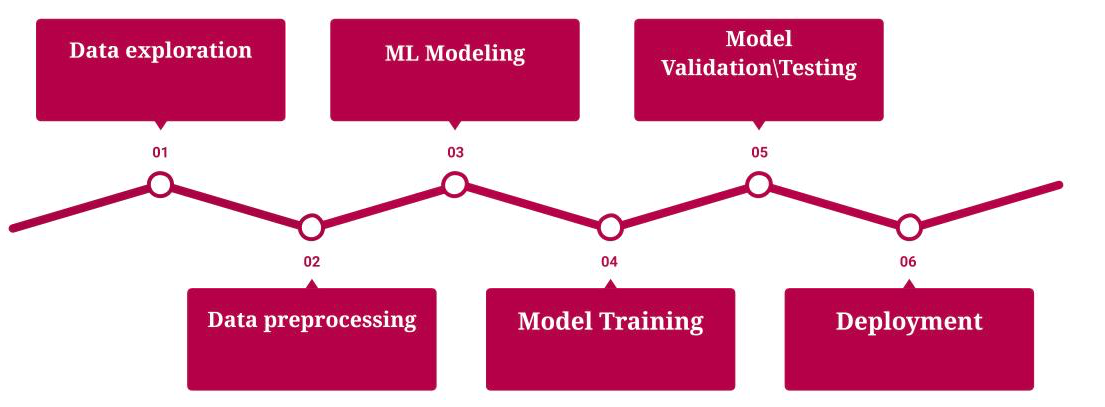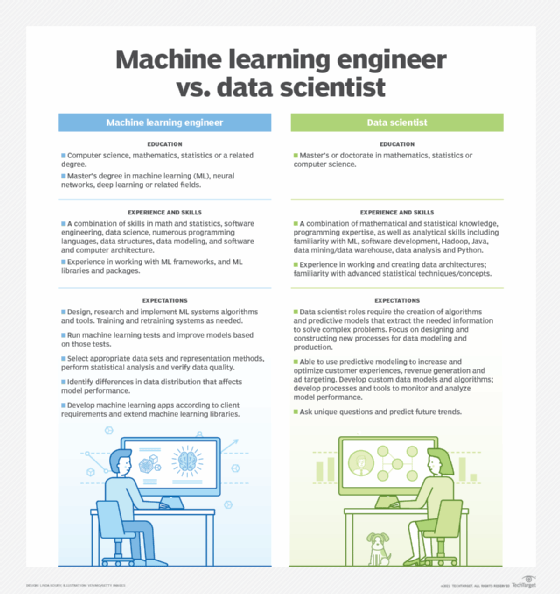All Categories
Featured
Table of Contents
- – Getting My Best Online Machine Learning Course...
- – The Definitive Guide for What Does A Machine L...
- – Machine Learning Online Course - Applied Mach...
- – The Ultimate Guide To Leverage Machine Learni...
- – The 10-Second Trick For No Code Ai And Machi...
- – Fascination About Machine Learning Engineer
- – The Advanced Machine Learning Course Diaries
Some individuals assume that that's disloyalty. Well, that's my entire occupation. If someone else did it, I'm going to use what that individual did. The lesson is placing that apart. I'm forcing myself to analyze the feasible solutions. It's more about consuming the web content and trying to use those ideas and less about locating a library that does the job or searching for someone else that coded it.
Dig a little bit deeper in the mathematics at the start, just so I can build that structure. Santiago: Lastly, lesson number 7. I do not think that you have to recognize the nuts and screws of every algorithm before you use it.
I've been using neural networks for the longest time. I do have a sense of just how the gradient descent functions. I can not explain it to you today. I would certainly need to go and examine back to in fact obtain a far better instinct. That doesn't mean that I can not solve points making use of semantic networks, right? (29:05) Santiago: Trying to compel people to think "Well, you're not mosting likely to succeed unless you can explain every solitary detail of just how this functions." It returns to our sorting example I assume that's just bullshit suggestions.
As an engineer, I have actually serviced numerous, lots of systems and I've made use of lots of, many points that I do not recognize the nuts and bolts of how it functions, even though I understand the effect that they have. That's the last lesson on that particular thread. Alexey: The funny thing is when I consider all these libraries like Scikit-Learn the formulas they utilize inside to implement, as an example, logistic regression or another thing, are not the very same as the formulas we study in maker discovering courses.
Getting My Best Online Machine Learning Courses And Programs To Work
Even if we attempted to discover to get all these basics of machine discovering, at the end, the algorithms that these collections utilize are different. Right? (30:22) Santiago: Yeah, absolutely. I think we require a whole lot extra pragmatism in the sector. Make a lot more of an effect. Or concentrating on supplying value and a little less of purism.

By the means, there are 2 various paths. I usually talk to those that wish to function in the industry that wish to have their impact there. There is a path for scientists and that is totally different. I do not risk to speak about that since I do not know.
However right there outside, in the sector, materialism goes a long method for certain. (32:13) Alexey: We had a remark that stated "Really feels even more like motivational speech than discussing transitioning." Possibly we should change. (32:40) Santiago: There you go, yeah. (32:48) Alexey: It is a good inspirational speech.
The Definitive Guide for What Does A Machine Learning Engineer Do?
One of the things I wanted to ask you. Initially, let's cover a pair of points. Alexey: Let's begin with core tools and structures that you need to learn to actually shift.
I recognize Java. I know SQL. I understand just how to make use of Git. I know Bash. Possibly I know Docker. All these points. And I become aware of artificial intelligence, it appears like a trendy point. What are the core devices and structures? Yes, I watched this video and I obtain persuaded that I do not need to obtain deep right into mathematics.
What are the core tools and structures that I require to learn to do this? (33:10) Santiago: Yeah, definitely. Excellent inquiry. I think, leading, you ought to start learning a bit of Python. Considering that you already recognize Java, I do not think it's mosting likely to be a substantial shift for you.
Not because Python is the exact same as Java, but in a week, you're gon na obtain a whole lot of the differences there. Santiago: Then you get particular core tools that are going to be utilized throughout your entire career.
Machine Learning Online Course - Applied Machine Learning - The Facts
You get SciKit Learn for the collection of equipment learning algorithms. Those are tools that you're going to have to be making use of. I do not advise simply going and learning about them out of the blue.
We can discuss particular training courses later. Take one of those training courses that are going to begin introducing you to some problems and to some core ideas of artificial intelligence. Santiago: There is a program in Kaggle which is an introduction. I do not remember the name, but if you go to Kaggle, they have tutorials there for cost-free.
What's good concerning it is that the only requirement for you is to know Python. They're going to offer a problem and tell you just how to utilize choice trees to solve that particular issue. I think that process is incredibly powerful, since you go from no maker finding out background, to understanding what the problem is and why you can not address it with what you recognize now, which is straight software application engineering techniques.
The Ultimate Guide To Leverage Machine Learning For Software Development - Gap
On the other hand, ML engineers concentrate on building and deploying maker knowing designs. They focus on training models with information to make predictions or automate jobs. While there is overlap, AI designers take care of even more diverse AI applications, while ML designers have a narrower focus on equipment knowing algorithms and their functional implementation.
Device knowing designers focus on developing and releasing equipment discovering models right into production systems. On the various other hand, information scientists have a wider function that consists of data collection, cleaning, expedition, and structure versions.
As companies progressively take on AI and machine knowing innovations, the need for proficient professionals grows. Artificial intelligence engineers work with cutting-edge projects, add to development, and have competitive incomes. Success in this area calls for continuous knowing and maintaining up with developing innovations and methods. Maker discovering duties are generally well-paid, with the possibility for high gaining potential.
ML is basically various from conventional software program growth as it concentrates on teaching computer systems to find out from data, instead than programming specific regulations that are implemented methodically. Unpredictability of end results: You are possibly utilized to composing code with foreseeable outcomes, whether your function runs once or a thousand times. In ML, nonetheless, the outcomes are less certain.

Pre-training and fine-tuning: Exactly how these designs are trained on substantial datasets and after that fine-tuned for specific tasks. Applications of LLMs: Such as message generation, belief analysis and information search and retrieval.
The 10-Second Trick For No Code Ai And Machine Learning: Building Data Science ...
The capacity to take care of codebases, combine modifications, and settle problems is just as vital in ML development as it is in standard software tasks. The abilities established in debugging and screening software application applications are very transferable. While the context may transform from debugging application logic to identifying problems in data processing or version training the underlying principles of organized examination, hypothesis screening, and iterative improvement are the very same.
Machine learning, at its core, is greatly reliant on stats and probability concept. These are crucial for recognizing how formulas discover from data, make forecasts, and assess their performance.
For those interested in LLMs, a complete understanding of deep knowing styles is beneficial. This includes not only the technicians of neural networks yet likewise the style of details versions for different usage instances, like CNNs (Convolutional Neural Networks) for photo processing and RNNs (Persistent Neural Networks) and transformers for consecutive data and all-natural language handling.
You need to understand these issues and discover techniques for identifying, mitigating, and communicating concerning predisposition in ML designs. This includes the potential influence of automated decisions and the ethical effects. Lots of versions, especially LLMs, require considerable computational sources that are frequently supplied by cloud systems like AWS, Google Cloud, and Azure.
Building these abilities will certainly not just promote a successful change right into ML but additionally make sure that programmers can add effectively and responsibly to the innovation of this vibrant area. Concept is necessary, however nothing defeats hands-on experience. Start working with jobs that allow you to apply what you've learned in a sensible context.
Construct your tasks: Start with straightforward applications, such as a chatbot or a message summarization tool, and slowly raise intricacy. The field of ML and LLMs is swiftly developing, with new breakthroughs and innovations arising on a regular basis.
Fascination About Machine Learning Engineer
Contribute to open-source tasks or write blog site posts regarding your learning trip and tasks. As you gain competence, begin looking for chances to integrate ML and LLMs right into your work, or look for brand-new roles concentrated on these technologies.

Potential use situations in interactive software, such as recommendation systems and automated decision-making. Recognizing unpredictability, basic analytical actions, and probability distributions. Vectors, matrices, and their function in ML algorithms. Mistake minimization techniques and slope descent described simply. Terms like design, dataset, functions, tags, training, inference, and validation. Information collection, preprocessing strategies, design training, assessment procedures, and implementation factors to consider.
Choice Trees and Random Woodlands: Intuitive and interpretable versions. Support Vector Machines: Maximum margin category. Matching problem kinds with suitable models. Balancing efficiency and intricacy. Standard structure of semantic networks: nerve cells, layers, activation features. Split computation and forward breeding. Feedforward Networks, Convolutional Neural Networks (CNNs), Reoccurring Neural Networks (RNNs). Image recognition, sequence forecast, and time-series evaluation.
Continual Integration/Continuous Implementation (CI/CD) for ML operations. Model tracking, versioning, and performance tracking. Spotting and resolving modifications in model efficiency over time.
The Advanced Machine Learning Course Diaries

You'll be presented to three of the most appropriate parts of the AI/ML technique; monitored understanding, neural networks, and deep learning. You'll realize the distinctions in between traditional programs and maker learning by hands-on growth in monitored discovering prior to constructing out complex dispersed applications with neural networks.
This course offers as an overview to machine lear ... Program Extra.
Table of Contents
- – Getting My Best Online Machine Learning Course...
- – The Definitive Guide for What Does A Machine L...
- – Machine Learning Online Course - Applied Mach...
- – The Ultimate Guide To Leverage Machine Learni...
- – The 10-Second Trick For No Code Ai And Machi...
- – Fascination About Machine Learning Engineer
- – The Advanced Machine Learning Course Diaries
Latest Posts
Jane Street Software Engineering Mock Interview – A Detailed Walkthrough
How To Prepare For A Software Developer Interview – Key Strategies
Why Communication Skills Matter In Software Engineering Interviews
More
Latest Posts
Jane Street Software Engineering Mock Interview – A Detailed Walkthrough
How To Prepare For A Software Developer Interview – Key Strategies
Why Communication Skills Matter In Software Engineering Interviews